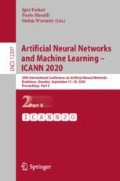Abstract
We introduce Logarithm-Networks (Log-Nets), a novel bio-inspired type of network architecture based on logarithms of feature maps followed by convolutions. Log-Nets are capable of surpassing the performance of traditional convolutional neural networks (CNNs) while using fewer parameters. Performance is evaluated on the Cifar-10 and ImageNet benchmarks.
Access this chapter
Tax calculation will be finalised at checkout
Purchases are for personal use only
References
Barth, E., Watson, A.B.: A geometric framework for nonlinear visual coding. Opt. Express 7(4), 155–165 (2000)
Bergstra, J., Desjardins, G., Lamblin, P., Bengio, Y.: Quadratic polynomials learn better image features. Technical report, 1337 (2009)
Berkes, P., Wiskott, L.: On the analysis and interpretation of inhomogeneous quadratic forms as receptive fields. Neural Comput. 18, 1868–1895 (2006)
Deng, J., Dong, W., Socher, R., Li, L.J., Li, K., Fei-Fei, L.: ImageNet: a large-scale hierarchical image database. In: CVPR 2009 (2009)
Frankle, J., Carbin, M.: The lottery ticket hypothesis: Finding sparse, trainable neural networks. arXiv preprint arXiv:1803.03635 (2018)
HasanPour, S.H., Rouhani, M., Fayyaz, M., Sabokrou, M.: Lets keep it simple, using simple architectures to outperform deeper and more complex architectures. arXiv preprint arXiv:1608.06037 (2016)
Hinton, G.F.: A parallel computation that assigns canonical object-based frames of reference. In: Proceedings of the 7th International Joint Conference on Artificial Intelligence, vol. 2, pp. 683–685 (1981)
Howard, J., et al.: fast.ai (2018). https://github.com/fastai/imagenet-fast/blob/master/imagenet_nv/fastai_imagenet.py
Huang, Y., et al.: GPipe: efficient training of giant neural networks using pipeline parallelism. In: Advances in Neural Information Processing Systems, pp. 103–112 (2019)
Hubel, D.H., Wiesel, T.N.: Receptive fields and functional architecture in two nonstriate visual areas (18 and 19) of the cat. J. Neurophysiol. 28(2), 229–289 (1965)
Iandola, F.N., Han, S., Moskewicz, M.W., Ashraf, K., Dally, W.J., Keutzer, K.: SqueezeNet: AlexNet-level accuracy with 50x fewer parameters and \(<\)0.5 mb model size. arXiv preprint arXiv:1602.07360 (2016)
Ioffe, S., Szegedy, C.: Batch normalization: accelerating deep network training by reducing internal covariate shift. In: International Conference on Machine Learning, pp. 448–456 (2015)
Krizhevsky, A., Nair, V., Hinton, G.: CIFAR-10 (Canadian Institute for Advanced Research). http://www.cs.toronto.edu/~kriz/cifar.html
Krizhevsky, A., Sutskever, I., Hinton, G.E.: ImageNet classification with deep convolutional neural networks. In: Advances in Neural Information Processing Systems, pp. 1097–1105 (2012)
kuangliu: pytorch-cifar (2020). https://github.com/kuangliu/pytorch-cifar/blob/master/models/efficientnet.py
Li, H., Kadav, A., Durdanovic, I., Samet, H., Graf, H.P.: Pruning filters for efficient convnets. arXiv preprint arXiv:1608.08710 (2016)
Mota, C., Barth, E.: On the uniqueness of curvature features. In: Baratoff, G., Neumann, H. (eds.) Dynamische Perzeption. Proceedings in Artificial Intelligence, Köln, vol. 9, pp. 175–178 (2000)
Paszke, A., et al.: PyTorch: an imperative style, high-performance deep learning library. In: Wallach, H., Larochelle, H., Beygelzimer, A., d’Alché-Buc, F., Fox, E., Garnett, R. (eds.) Advances in Neural Information Processing Systems, vol. 32, pp. 8024–8035. Curran Associates, Inc. (2019)
Poon, H., Domingos, P.: Sum-product networks: a new deep architecture. In: 2011 IEEE International Conference on Computer Vision Workshops (ICCV Workshops), pp. 689–690. IEEE (2011)
Sabour, S., Frosst, N., Hinton, G.E.: Dynamic routing between capsules. In: Advances in Neural Information Processing Systems, pp. 3856–3866 (2017)
Sandler, M., Howard, A., Zhu, M., Zhmoginov, A., Chen, L.C.: MobileNetV2: inverted residuals and linear bottlenecks. In: Proceedings of the IEEE Conference on Computer Vision and Pattern Recognition, pp. 4510–4520 (2018)
Shridhar, K., Laumann, F., Liwicki, M.: A comprehensive guide to Bayesian convolutional neural network with variational inference. arXiv preprint arXiv:1901.02731 (2019)
Springenberg, J., Dosovitskiy, A., Brox, T., Riedmiller, M.: Striving for simplicity: the all convolutional net. In: ICLR (workshop track) (2015)
Stojnic, R., Taylor, R.: ImageNet leaderboard (2020). https://paperswithcode.com/sota/image-classification-on-imagenet
Tan, M., et al.: MnasNet: platform-aware neural architecture search for mobile. In: Proceedings of the IEEE Conference on Computer Vision and Pattern Recognition, pp. 2820–2828 (2019)
Tan, M., Le, Q.: EfficientNet: rethinking model scaling for convolutional neural networks. In: International Conference on Machine Learning, pp. 6105–6114 (2019)
Tan, M., Le, Q.V.: MixConv: Mixed depthwise convolutional kernels. CoRR, abs/1907.09595 (2019)
Veniat, T., Denoyer, L.: Learning time/memory-efficient deep architectures with budgeted super networks. In: Proceedings of the IEEE Conference on Computer Vision and Pattern Recognition, pp. 3492–3500 (2018)
Volterra, V.: Theory of Functionals and of Integral and Integro-differential Equations. Dover Publications, Mineola, New York (1959)
Wang, Q., Wu, B., Zhu, P., Li, P., Zuo, W., Hu, Q.: ECA-Net: Efficient channel attention for deep convolutional neural networks. arXiv preprint arXiv:1910.03151 (2019)
Xie, L., Yuille, A.: Genetic CNN. In: Proceedings of the IEEE International Conference on Computer Vision, pp. 1379–1388 (2017)
Zagoruyko, S., Komodakis, N.: Wide residual networks. arXiv preprint arXiv:1605.07146 (2016)
Zetzsche, C., Barth, E.: Fundamental limits of linear filters in the visual processing of two-dimensional signals. Vis. Res. 30, 1111–1117 (1990)
Zetzsche, C., Barth, E., Wegmann, B.: The importance of intrinsically two-dimensional image features in biological vision and picture coding. In: Watson, A.B. (ed.) Digital Images and Human Vision, pp. 109–38. MIT Press (October 1993)
Zhang, X., Zhou, X., Lin, M., Sun, J.: ShuffleNet: an extremely efficient convolutional neural network for mobile devices. In: Proceedings of the IEEE Conference on Computer Vision and Pattern Recognition, pp. 6848–6856 (2018)
Zoumpourlis, G., Doumanoglou, A., Vretos, N., Daras, P.: Non-linear convolution filters for CVV-based learning. In: Proceedings of the IEEE International Conference on Computer Vision, pp. 4761–4769 (2017)
Author information
Authors and Affiliations
Corresponding author
Editor information
Editors and Affiliations
Rights and permissions
Copyright information
© 2020 Springer Nature Switzerland AG
About this paper
Cite this paper
Grüning, P., Martinetz, T., Barth, E. (2020). Log-Nets: Logarithmic Feature-Product Layers Yield More Compact Networks. In: Farkaš, I., Masulli, P., Wermter, S. (eds) Artificial Neural Networks and Machine Learning – ICANN 2020. ICANN 2020. Lecture Notes in Computer Science(), vol 12397. Springer, Cham. https://doi.org/10.1007/978-3-030-61616-8_7
Download citation
DOI: https://doi.org/10.1007/978-3-030-61616-8_7
Published:
Publisher Name: Springer, Cham
Print ISBN: 978-3-030-61615-1
Online ISBN: 978-3-030-61616-8
eBook Packages: Computer ScienceComputer Science (R0)

